| Listing 1 - 10 of 11 | << page >> |
Sort by
|
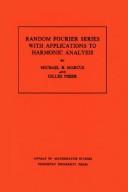
ISBN: 0691082898 0691082928 1400881536 Year: 1981 Volume: no. 101 Publisher: Princeton : Tokyo : Princeton University Press University of Tokyo press,
Abstract | Keywords | Export | Availability | Bookmark
 Loading...
Loading...Choose an application
- Reference Manager
- EndNote
- RefWorks (Direct export to RefWorks)
In this book the authors give the first necessary and sufficient conditions for the uniform convergence a.s. of random Fourier series on locally compact Abelian groups and on compact non-Abelian groups. They also obtain many related results. For example, whenever a random Fourier series converges uniformly a.s. it also satisfies the central limit theorem. The methods developed are used to study some questions in harmonic analysis that are not intrinsically random. For example, a new characterization of Sidon sets is derived.The major results depend heavily on the Dudley-Fernique necessary and sufficient condition for the continuity of stationary Gaussian processes and on recent work on sums of independent Banach space valued random variables. It is noteworthy that the proofs for the Abelian case immediately extend to the non-Abelian case once the proper definition of random Fourier series is made. In doing this the authors obtain new results on sums of independent random matrices with elements in a Banach space. The final chapter of the book suggests several directions for further research.
Harmonic analysis. Fourier analysis --- Fourier series. --- Harmonic analysis. --- Fourier, Séries de --- Analyse harmonique --- 517.518.4 --- Fourier series --- Harmonic analysis --- Analysis (Mathematics) --- Functions, Potential --- Potential functions --- Banach algebras --- Calculus --- Mathematical analysis --- Mathematics --- Bessel functions --- Harmonic functions --- Time-series analysis --- Fourier integrals --- Series, Fourier --- Series, Trigonometric --- Trigonometric series --- Fourier analysis --- 517.518.4 Trigonometric series --- Fourier, Séries de --- Abelian group. --- Almost periodic function. --- Almost surely. --- Banach space. --- Big O notation. --- Cardinality. --- Central limit theorem. --- Circle group. --- Coefficient. --- Commutative property. --- Compact group. --- Compact space. --- Complex number. --- Continuous function. --- Corollary. --- Discrete group. --- Equivalence class. --- Existential quantification. --- Finite group. --- Gaussian process. --- Haar measure. --- Independence (probability theory). --- Inequality (mathematics). --- Integer. --- Irreducible representation. --- Non-abelian group. --- Non-abelian. --- Normal distribution. --- Orthogonal group. --- Orthogonal matrix. --- Probability distribution. --- Probability measure. --- Probability space. --- Probability. --- Random function. --- Random matrix. --- Random variable. --- Rate of convergence. --- Real number. --- Ring (mathematics). --- Scientific notation. --- Set (mathematics). --- Slepian's lemma. --- Small number. --- Smoothness. --- Stationary process. --- Subgroup. --- Subset. --- Summation. --- Theorem. --- Uniform convergence. --- Unitary matrix. --- Variance.
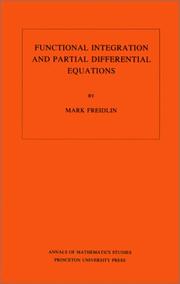
ISBN: 0691083541 1400881595 Year: 2016 Publisher: Princeton, NJ : Princeton University Press,
Abstract | Keywords | Export | Availability | Bookmark
 Loading...
Loading...Choose an application
- Reference Manager
- EndNote
- RefWorks (Direct export to RefWorks)
This book discusses some aspects of the theory of partial differential equations from the viewpoint of probability theory. It is intended not only for specialists in partial differential equations or probability theory but also for specialists in asymptotic methods and in functional analysis. It is also of interest to physicists who use functional integrals in their research. The work contains results that have not previously appeared in book form, including research contributions of the author.
Partial differential equations --- Differential equations, Partial. --- Probabilities. --- Integration, Functional. --- Functional integration --- Functional analysis --- Integrals, Generalized --- Probability --- Statistical inference --- Combinations --- Mathematics --- Chance --- Least squares --- Mathematical statistics --- Risk --- A priori estimate. --- Absolute continuity. --- Almost surely. --- Analytic continuation. --- Axiom. --- Big O notation. --- Boundary (topology). --- Boundary value problem. --- Bounded function. --- Calculation. --- Cauchy problem. --- Central limit theorem. --- Characteristic function (probability theory). --- Chebyshev's inequality. --- Coefficient. --- Comparison theorem. --- Continuous function (set theory). --- Continuous function. --- Convergence of random variables. --- Cylinder set. --- Degeneracy (mathematics). --- Derivative. --- Differential equation. --- Differential operator. --- Diffusion equation. --- Diffusion process. --- Dimension (vector space). --- Direct method in the calculus of variations. --- Dirichlet boundary condition. --- Dirichlet problem. --- Eigenfunction. --- Eigenvalues and eigenvectors. --- Elliptic operator. --- Elliptic partial differential equation. --- Equation. --- Existence theorem. --- Exponential function. --- Feynman–Kac formula. --- Fokker–Planck equation. --- Function space. --- Functional analysis. --- Fundamental solution. --- Gaussian measure. --- Girsanov theorem. --- Hessian matrix. --- Hölder condition. --- Independence (probability theory). --- Integral curve. --- Integral equation. --- Invariant measure. --- Iterated logarithm. --- Itô's lemma. --- Joint probability distribution. --- Laplace operator. --- Laplace's equation. --- Lebesgue measure. --- Limit (mathematics). --- Limit cycle. --- Limit point. --- Linear differential equation. --- Linear map. --- Lipschitz continuity. --- Markov chain. --- Markov process. --- Markov property. --- Maximum principle. --- Mean value theorem. --- Measure (mathematics). --- Modulus of continuity. --- Moment (mathematics). --- Monotonic function. --- Navier–Stokes equations. --- Nonlinear system. --- Ordinary differential equation. --- Parameter. --- Partial differential equation. --- Periodic function. --- Poisson kernel. --- Probabilistic method. --- Probability space. --- Probability theory. --- Probability. --- Random function. --- Regularization (mathematics). --- Schrödinger equation. --- Self-adjoint operator. --- Sign (mathematics). --- Simultaneous equations. --- Smoothness. --- State-space representation. --- Stochastic calculus. --- Stochastic differential equation. --- Stochastic. --- Support (mathematics). --- Theorem. --- Theory. --- Uniqueness theorem. --- Variable (mathematics). --- Weak convergence (Hilbert space). --- Wiener process.
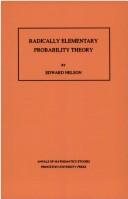
ISBN: 0691084734 0691084742 1400882141 Year: 2016 Publisher: Princeton, NJ : Princeton University Press,
Abstract | Keywords | Export | Availability | Bookmark
 Loading...
Loading...Choose an application
- Reference Manager
- EndNote
- RefWorks (Direct export to RefWorks)
Using only the very elementary framework of finite probability spaces, this book treats a number of topics in the modern theory of stochastic processes. This is made possible by using a small amount of Abraham Robinson's nonstandard analysis and not attempting to convert the results into conventional form.
Martingales (Mathematics) --- Stochastic processes. --- Probabilities. --- Martingales (Mathematics). --- Stochastic processes --- Probability --- Statistical inference --- Combinations --- Mathematics --- Chance --- Least squares --- Mathematical statistics --- Risk --- Random processes --- Probabilities --- Abraham Robinson. --- Absolute value. --- Addition. --- Algebra of random variables. --- Almost surely. --- Axiom. --- Axiomatic system. --- Borel set. --- Bounded function. --- Cantor's diagonal argument. --- Cardinality. --- Cartesian product. --- Central limit theorem. --- Chebyshev's inequality. --- Compact space. --- Contradiction. --- Convergence of random variables. --- Corollary. --- Correlation coefficient. --- Counterexample. --- Dimension (vector space). --- Dimension. --- Division by zero. --- Elementary function. --- Estimation. --- Existential quantification. --- Family of sets. --- Finite set. --- Hyperplane. --- Idealization. --- Independence (probability theory). --- Indicator function. --- Infinitesimal. --- Internal set theory. --- Joint probability distribution. --- Law of large numbers. --- Linear function. --- Martingale (probability theory). --- Mathematical induction. --- Mathematician. --- Mathematics. --- Measure (mathematics). --- N0. --- Natural number. --- Non-standard analysis. --- Norm (mathematics). --- Orthogonal complement. --- Parameter. --- Path space. --- Predictable process. --- Probability distribution. --- Probability measure. --- Probability space. --- Probability theory. --- Probability. --- Product topology. --- Projection (linear algebra). --- Quadratic variation. --- Random variable. --- Real number. --- Requirement. --- Scientific notation. --- Sequence. --- Set (mathematics). --- Significant figures. --- Special case. --- Standard deviation. --- Statistical mechanics. --- Stochastic process. --- Subalgebra. --- Subset. --- Summation. --- Theorem. --- Theory. --- Total variation. --- Transfer principle. --- Transfinite number. --- Trigonometric functions. --- Upper and lower bounds. --- Variable (mathematics). --- Variance. --- Vector space. --- W0. --- Wiener process. --- Without loss of generality.
Book
ISBN: 0691080747 1322884773 0691621411 0691648077 1400868572 9780691080741 Year: 2015 Publisher: Princeton, NJ : Princeton University Press,
Abstract | Keywords | Export | Availability | Bookmark
 Loading...
Loading...Choose an application
- Reference Manager
- EndNote
- RefWorks (Direct export to RefWorks)
Encompassing both introductory and more advanced research material, these notes deal with the author's contributions to stochastic processes and focus on Brownian motion processes and its derivative white noise.Originally published in 1970.The Princeton Legacy Library uses the latest print-on-demand technology to again make available previously out-of-print books from the distinguished backlist of Princeton University Press. These editions preserve the original texts of these important books while presenting them in durable paperback and hardcover editions. The goal of the Princeton Legacy Library is to vastly increase access to the rich scholarly heritage found in the thousands of books published by Princeton University Press since its founding in 1905.
Stationary processes --- Stationary processes. --- Stochastic processes --- 519.216 --- 519.216 Stochastic processes in general. Prediction theory. Stopping times. Martingales --- Stochastic processes in general. Prediction theory. Stopping times. Martingales --- Bochner integral. --- Bochner's theorem. --- Bounded operator. --- Bounded variation. --- Brownian motion. --- Characteristic exponent. --- Characteristic function (probability theory). --- Complexification. --- Compound Poisson process. --- Computation. --- Conditional expectation. --- Continuous function (set theory). --- Continuous function. --- Continuous linear operator. --- Convergence of random variables. --- Coset. --- Covariance function. --- Cyclic subspace. --- Cylinder set. --- Degrees of freedom (statistics). --- Derivative. --- Differential equation. --- Dimension (vector space). --- Dirac delta function. --- Discrete spectrum. --- Distribution function. --- Dual space. --- Eigenfunction. --- Equation. --- Existential quantification. --- Exponential distribution. --- Exponential function. --- Finite difference. --- Fourier series. --- Fourier transform. --- Function (mathematics). --- Function space. --- Gaussian measure. --- Gaussian process. --- Harmonic analysis. --- Hermite polynomials. --- Hilbert space. --- Homeomorphism. --- Independence (probability theory). --- Independent and identically distributed random variables. --- Indicator function. --- Infinitesimal generator (stochastic processes). --- Integral equation. --- Isometry. --- Joint probability distribution. --- Langevin equation. --- Lebesgue measure. --- Lie algebra. --- Limit superior and limit inferior. --- Linear combination. --- Linear function. --- Linear interpolation. --- Linear subspace. --- Mean squared error. --- Measure (mathematics). --- Monotonic function. --- Normal distribution. --- Normal subgroup. --- Nuclear space. --- One-parameter group. --- Orthogonality. --- Orthogonalization. --- Parameter. --- Poisson point process. --- Polynomial. --- Probability distribution. --- Probability measure. --- Probability space. --- Probability. --- Projective linear group. --- Radon–Nikodym theorem. --- Random function. --- Random variable. --- Reproducing kernel Hilbert space. --- Self-adjoint operator. --- Self-adjoint. --- Semigroup. --- Shift operator. --- Special case. --- Stable process. --- Stationary process. --- Stochastic differential equation. --- Stochastic process. --- Stochastic. --- Subgroup. --- Summation. --- Symmetrization. --- Theorem. --- Transformation semigroup. --- Unitary operator. --- Unitary representation. --- Unitary transformation. --- Variance. --- White noise. --- Zero element.
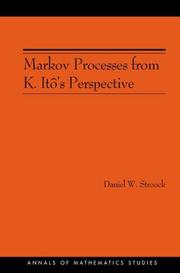
ISBN: 0691115427 1400835577 0691115435 1322063230 9781400835577 9781322063232 9780691115436 9870691115427 9780691115429 Year: 2003 Publisher: Princeton, New Jersey ; Oxfordshire, England : Princeton University Press,
Abstract | Keywords | Export | Availability | Bookmark
 Loading...
Loading...Choose an application
- Reference Manager
- EndNote
- RefWorks (Direct export to RefWorks)
Kiyosi Itô's greatest contribution to probability theory may be his introduction of stochastic differential equations to explain the Kolmogorov-Feller theory of Markov processes. Starting with the geometric ideas that guided him, this book gives an account of Itô's program. The modern theory of Markov processes was initiated by A. N. Kolmogorov. However, Kolmogorov's approach was too analytic to reveal the probabilistic foundations on which it rests. In particular, it hides the central role played by the simplest Markov processes: those with independent, identically distributed increments. To remedy this defect, Itô interpreted Kolmogorov's famous forward equation as an equation that describes the integral curve of a vector field on the space of probability measures. Thus, in order to show how Itô's thinking leads to his theory of stochastic integral equations, Stroock begins with an account of integral curves on the space of probability measures and then arrives at stochastic integral equations when he moves to a pathspace setting. In the first half of the book, everything is done in the context of general independent increment processes and without explicit use of Itô's stochastic integral calculus. In the second half, the author provides a systematic development of Itô's theory of stochastic integration: first for Brownian motion and then for continuous martingales. The final chapter presents Stratonovich's variation on Itô's theme and ends with an application to the characterization of the paths on which a diffusion is supported. The book should be accessible to readers who have mastered the essentials of modern probability theory and should provide such readers with a reasonably thorough introduction to continuous-time, stochastic processes.
Markov processes. --- Stochastic difference equations. --- Itō, Kiyosi, --- Analysis, Markov --- Chains, Markov --- Markoff processes --- Markov analysis --- Markov chains --- Markov models --- Models, Markov --- Processes, Markov --- Itō, K. --- Ito, Kiesi, --- Itō, Kiyoshi, --- 伊藤淸, --- 伊藤清, --- Itō, Kiyosi, --- Itō, Kiyosi, 1915-2008. --- Stochastic difference equations --- Difference equations --- Stochastic processes --- Abelian group. --- Addition. --- Analytic function. --- Approximation. --- Bernhard Riemann. --- Bounded variation. --- Brownian motion. --- Central limit theorem. --- Change of variables. --- Coefficient. --- Complete metric space. --- Compound Poisson process. --- Continuous function (set theory). --- Continuous function. --- Convergence of measures. --- Convex function. --- Coordinate system. --- Corollary. --- David Hilbert. --- Decomposition theorem. --- Degeneracy (mathematics). --- Derivative. --- Diffeomorphism. --- Differentiable function. --- Differentiable manifold. --- Differential equation. --- Differential geometry. --- Dimension. --- Directional derivative. --- Doob–Meyer decomposition theorem. --- Duality principle. --- Elliptic operator. --- Equation. --- Euclidean space. --- Existential quantification. --- Fourier transform. --- Function space. --- Functional analysis. --- Fundamental solution. --- Fundamental theorem of calculus. --- Homeomorphism. --- Hölder's inequality. --- Initial condition. --- Integral curve. --- Integral equation. --- Integration by parts. --- Invariant measure. --- Itô calculus. --- Itô's lemma. --- Joint probability distribution. --- Lebesgue measure. --- Linear interpolation. --- Lipschitz continuity. --- Local martingale. --- Logarithm. --- Markov chain. --- Markov process. --- Markov property. --- Martingale (probability theory). --- Normal distribution. --- Ordinary differential equation. --- Ornstein–Uhlenbeck process. --- Polynomial. --- Principal part. --- Probability measure. --- Probability space. --- Probability theory. --- Pseudo-differential operator. --- Radon–Nikodym theorem. --- Representation theorem. --- Riemann integral. --- Riemann sum. --- Riemann–Stieltjes integral. --- Scientific notation. --- Semimartingale. --- Sign (mathematics). --- Special case. --- Spectral sequence. --- Spectral theory. --- State space. --- State-space representation. --- Step function. --- Stochastic calculus. --- Stochastic. --- Stratonovich integral. --- Submanifold. --- Support (mathematics). --- Tangent space. --- Tangent vector. --- Taylor's theorem. --- Theorem. --- Theory. --- Topological space. --- Topology. --- Translational symmetry. --- Uniform convergence. --- Variable (mathematics). --- Vector field. --- Weak convergence (Hilbert space). --- Weak topology.
Book
ISBN: 1400865255 9781400865253 Year: 2006 Publisher: Princeton, New Jersey ; Oxfordshire, England : Princeton University Press,
Abstract | Keywords | Export | Availability | Bookmark
 Loading...
Loading...Choose an application
- Reference Manager
- EndNote
- RefWorks (Direct export to RefWorks)
Diffusive motion--displacement due to the cumulative effect of irregular fluctuations--has been a fundamental concept in mathematics and physics since Einstein's work on Brownian motion. It is also relevant to understanding various aspects of quantum theory. This book explains diffusive motion and its relation to both nonrelativistic quantum theory and quantum field theory. It shows how diffusive motion concepts lead to a radical reexamination of the structure of mathematical analysis. The book's inspiration is Princeton University mathematics professor Edward Nelson's influential work in probability, functional analysis, nonstandard analysis, stochastic mechanics, and logic. The book can be used as a tutorial or reference, or read for pleasure by anyone interested in the role of mathematics in science. Because of the application of diffusive motion to quantum theory, it will interest physicists as well as mathematicians. The introductory chapter describes the interrelationships between the various themes, many of which were first brought to light by Edward Nelson. In his writing and conversation, Nelson has always emphasized and relished the human aspect of mathematical endeavor. In his intellectual world, there is no sharp boundary between the mathematical, the cultural, and the spiritual. It is fitting that the final chapter provides a mathematical perspective on musical theory, one that reveals an unexpected connection with some of the book's main themes.
Mathematical physics. --- Diffusion. --- Quantum theory. --- Quantum dynamics --- Quantum mechanics --- Quantum physics --- Physics --- Mechanics --- Thermodynamics --- Gases --- Liquids --- Separation (Technology) --- Solution (Chemistry) --- Solutions, Solid --- Matter --- Packed towers --- Semiconductor doping --- Physical mathematics --- Diffusion --- Properties --- Mathematics --- Affine space. --- Algebra. --- Axiom. --- Bell's theorem. --- Brownian motion. --- Central limit theorem. --- Classical mathematics. --- Classical mechanics. --- Clifford algebra. --- Combinatorial proof. --- Commutative property. --- Constructive quantum field theory. --- Continuum hypothesis. --- David Hilbert. --- Dimension (vector space). --- Discrete mathematics. --- Distribution (mathematics). --- Eigenfunction. --- Equation. --- Euclidean space. --- Experimental mathematics. --- Fermi–Dirac statistics. --- Feynman–Kac formula. --- First-order logic. --- Fokker–Planck equation. --- Foundations of mathematics. --- Fractal dimension. --- Gaussian process. --- Girsanov theorem. --- Gödel's incompleteness theorems. --- Hilbert space. --- Hilbert's program. --- Holomorphic function. --- Infinitesimal. --- Integer. --- Internal set theory. --- Interval (mathematics). --- Limit (mathematics). --- Mathematical induction. --- Mathematical optimization. --- Mathematical proof. --- Mathematician. --- Mathematics. --- Measurable function. --- Measure (mathematics). --- Minkowski space. --- Natural number. --- Neo-Riemannian theory. --- Non-standard analysis. --- Number theory. --- Operator algebra. --- Ornstein–Uhlenbeck process. --- Orthonormal basis. --- Perturbation theory (quantum mechanics). --- Philosophy of mathematics. --- Predicate (mathematical logic). --- Probability measure. --- Probability space. --- Probability theory. --- Probability. --- Projection (linear algebra). --- Pure mathematics. --- Pythagorean theorem. --- Quantum field theory. --- Quantum fluctuation. --- Quantum gravity. --- Quantum harmonic oscillator. --- Quantum mechanics. --- Quantum system. --- Quantum teleportation. --- Random variable. --- Real number. --- Renormalization group. --- Renormalization. --- Riemann mapping theorem. --- Riemann surface. --- Riemannian geometry. --- Riemannian manifold. --- Schrödinger equation. --- Scientific notation. --- Set (mathematics). --- Sign (mathematics). --- Sobolev inequality. --- Special relativity. --- Spectral theorem. --- Spin (physics). --- Statistical mechanics. --- Stochastic calculus. --- Stochastic differential equation. --- Tensor algebra. --- Theorem. --- Theoretical physics. --- Theory. --- Turing machine. --- Variable (mathematics). --- Von Neumann algebra. --- Wiener process. --- Wightman axioms. --- Zermelo–Fraenkel set theory.
Book
ISBN: 1400826950 Year: 2005 Publisher: Princeton, NJ : Princeton University Press,
Abstract | Keywords | Export | Availability | Bookmark
 Loading...
Loading...Choose an application
- Reference Manager
- EndNote
- RefWorks (Direct export to RefWorks)
It is now some thirty years since Deligne first proved his general equidistribution theorem, thus establishing the fundamental result governing the statistical properties of suitably "pure" algebro-geometric families of character sums over finite fields (and of their associated L-functions). Roughly speaking, Deligne showed that any such family obeys a "generalized Sato-Tate law," and that figuring out which generalized Sato-Tate law applies to a given family amounts essentially to computing a certain complex semisimple (not necessarily connected) algebraic group, the "geometric monodromy group" attached to that family. Up to now, nearly all techniques for determining geometric monodromy groups have relied, at least in part, on local information. In Moments, Monodromy, and Perversity, Nicholas Katz develops new techniques, which are resolutely global in nature. They are based on two vital ingredients, neither of which existed at the time of Deligne's original work on the subject. The first is the theory of perverse sheaves, pioneered by Goresky and MacPherson in the topological setting and then brilliantly transposed to algebraic geometry by Beilinson, Bernstein, Deligne, and Gabber. The second is Larsen's Alternative, which very nearly characterizes classical groups by their fourth moments. These new techniques, which are of great interest in their own right, are first developed and then used to calculate the geometric monodromy groups attached to some quite specific universal families of (L-functions attached to) character sums over finite fields.
Monodromy groups. --- Sheaf theory. --- L-functions. --- Addition. --- Additive group. --- Affine space. --- Algebraic group. --- Algebraic integer. --- Algebraically closed field. --- Automorphism. --- Base change. --- Big O notation. --- Central moment. --- Change of base. --- Character sum. --- Classical group. --- Codimension. --- Computation. --- Conjecture. --- Conjugacy class. --- Constant function. --- Convolution. --- Corollary. --- Critical value. --- Dense set. --- Determinant. --- Dimension (vector space). --- Dimension. --- Diophantine equation. --- Direct sum. --- Discrete group. --- Disjoint sets. --- Divisor (algebraic geometry). --- Divisor. --- Eigenvalues and eigenvectors. --- Elliptic curve. --- Empty set. --- Equidistribution theorem. --- Existential quantification. --- Exponential sum. --- Faithful representation. --- Finite field. --- Finite group. --- Fourier transform. --- Function field. --- Function space. --- Generic point. --- Group theory. --- Hypersurface. --- Inequality (mathematics). --- Integer. --- Irreducible representation. --- Isomorphism class. --- L-function. --- Leray spectral sequence. --- Linear space (geometry). --- Linear subspace. --- Moment (mathematics). --- Monodromy. --- Morphism. --- Natural number. --- Normal subgroup. --- Orthogonal group. --- P-value. --- Parameter space. --- Parameter. --- Parity (mathematics). --- Partition of a set. --- Perverse sheaf. --- Polynomial. --- Power series. --- Prime number. --- Probability space. --- Probability theory. --- Proper morphism. --- Pullback (category theory). --- Random variable. --- Reductive group. --- Relative dimension. --- Root of unity. --- Scalar multiplication. --- Scientific notation. --- Set (mathematics). --- Sheaf (mathematics). --- Special case. --- Subgroup. --- Subobject. --- Subset. --- Summation. --- Surjective function. --- Symmetric group. --- Symplectic group. --- Tensor product. --- Theorem. --- Theory. --- Topology. --- Trace (linear algebra). --- Trivial group. --- Unipotent. --- Variable (mathematics). --- Variance. --- Vector space. --- Zariski topology.
Book
ISBN: 1400833086 Year: 2009 Publisher: Princeton ; Oxford : Princeton University Press,
Abstract | Keywords | Export | Availability | Bookmark
 Loading...
Loading...Choose an application
- Reference Manager
- EndNote
- RefWorks (Direct export to RefWorks)
The authors offer an introduction to mathematical analysis with applications in economic theory & econometrics.
Economics, Mathematical. --- Mathematical analysis. --- Econometrics. --- Approximation. --- Axiom of choice. --- Banach space. --- Bijection. --- Bounded function. --- Budget set. --- Calculation. --- Cardinality. --- Cauchy sequence. --- Central limit theorem. --- Combination. --- Compact space. --- Complete metric space. --- Concave function. --- Conditional expectation. --- Continuous function (set theory). --- Continuous function. --- Contraction mapping. --- Contradiction. --- Convex analysis. --- Convex set. --- Countable set. --- Dense set. --- Differentiable function. --- Dimension (vector space). --- Dimension. --- Division by zero. --- Dynamic programming. --- Empty set. --- Equation. --- Equivalence class. --- Estimator. --- Existential quantification. --- Finite set. --- Fixed-point theorem. --- Function (mathematics). --- Hahn–Banach theorem. --- Independence (probability theory). --- Indicator function. --- Inequality (mathematics). --- Infimum and supremum. --- Intermediate value theorem. --- Karush–Kuhn–Tucker conditions. --- Law of large numbers. --- Lebesgue measure. --- Limit of a sequence. --- Limit superior and limit inferior. --- Linear algebra. --- Linear function. --- Linear map. --- Linear subspace. --- Loss function. --- Markov chain. --- Mathematical optimization. --- Mathematics. --- Maximal element. --- Measurable function. --- Measure (mathematics). --- Metric space. --- Monotonic function. --- Normed vector space. --- Null set. --- Open set. --- Optimization problem. --- Parameter. --- Pareto efficiency. --- Partially ordered set. --- Preference (economics). --- Preference relation. --- Probability distribution. --- Probability space. --- Probability theory. --- Probability. --- Quantity. --- Random variable. --- Rational number. --- Real number. --- Scientific notation. --- Sequence. --- Set (mathematics). --- Simple function. --- Special case. --- Stochastic process. --- Stone–Weierstrass theorem. --- Subsequence. --- Subset. --- Summation. --- Surjective function. --- Theorem. --- Topological space. --- Topology. --- Uncountable set. --- Uniform continuity. --- Uniform distribution (discrete). --- Union (set theory). --- Upper and lower bounds. --- Utility. --- Variable (mathematics). --- Vector space. --- Zorn's lemma.
Book
ISBN: 1400881609 Year: 2016 Publisher: Princeton, NJ : Princeton University Press,
Abstract | Keywords | Export | Availability | Bookmark
 Loading...
Loading...Choose an application
- Reference Manager
- EndNote
- RefWorks (Direct export to RefWorks)
The description for this book, Stationary Processes and Prediction Theory. (AM-44), Volume 44, will be forthcoming.
Stochastic processes. --- Mathematical statistics. --- Abelian group. --- Adjoint equation. --- Almost periodic function. --- Almost surely. --- Automorphism. --- C*-algebra. --- Cartesian product. --- Character group. --- Characteristic function (probability theory). --- Coefficient. --- Commutative property. --- Complex number. --- Conditional expectation. --- Conditional probability. --- Continuous function (set theory). --- Continuous function. --- Corollary. --- Coset. --- Counterexample. --- Degeneracy (mathematics). --- Dimension (vector space). --- Dimensional analysis. --- Distribution function. --- Eigenvalues and eigenvectors. --- Endomorphism. --- Equation. --- Equivalence class. --- Equivalence relation. --- Ergodic process. --- Ergodic sequence. --- Ergodic theory. --- Ergodicity. --- Error term. --- Estimation. --- Euclidean space. --- Eventually (mathematics). --- Existence theorem. --- Existential quantification. --- Expectation value (quantum mechanics). --- Extrapolation. --- Fourier series. --- Fubini's theorem. --- Function (mathematics). --- Function composition. --- Functional equation. --- Generic point. --- Harmonic analysis. --- Hilbert space. --- Homeomorphism. --- Homomorphism. --- Identity element. --- Independence (probability theory). --- Inverse function. --- Invertible matrix. --- Least squares. --- Lebesgue measure. --- Limit (mathematics). --- Linear combination. --- Linear map. --- Linear prediction. --- Linear space (geometry). --- Markov chain. --- Metric space. --- Nonlinear system. --- Nonnegative matrix. --- Normed algebra. --- Parameter. --- Periodic sequence. --- Pointwise. --- Predictability. --- Prediction. --- Probability distribution. --- Probability measure. --- Probability space. --- Probability. --- Quotient space (topology). --- Random sequence. --- Random variable. --- Regular sequence. --- Sample space. --- Semigroup. --- Sequence space. --- Sequence. --- Shift operator. --- Sign (mathematics). --- Special case. --- Stationary process. --- Stochastic process. --- Stochastic. --- Subalgebra. --- Subgroup. --- Subsequence. --- Subset. --- Theorem. --- Time series. --- Topology. --- Uniform convergence. --- Variable (mathematics). --- Weak topology. --- Zorn's lemma.
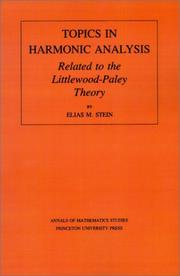
ISBN: 0691080674 1400881870 9780691080673 Year: 1970 Volume: 63 Publisher: Princeton : Princeton University Press,
Abstract | Keywords | Export | Availability | Bookmark
 Loading...
Loading...Choose an application
- Reference Manager
- EndNote
- RefWorks (Direct export to RefWorks)
This work deals with an extension of the classical Littlewood-Paley theory in the context of symmetric diffusion semigroups. In this general setting there are applications to a variety of problems, such as those arising in the study of the expansions coming from second order elliptic operators. A review of background material in Lie groups and martingale theory is included to make the monograph more accessible to the student.
Harmonic analysis. Fourier analysis --- Harmonic analysis --- Semigroups --- 517.986.6 --- Lie groups --- Littlewood-Paley theory --- #WWIS:d.d. Prof. L. Bouckaert/BOUC --- Fourier analysis --- Functions of several real variables --- Group theory --- Groups, Lie --- Lie algebras --- Symmetric spaces --- Topological groups --- Analysis (Mathematics) --- Functions, Potential --- Potential functions --- Banach algebras --- Calculus --- Mathematical analysis --- Mathematics --- Bessel functions --- Fourier series --- Harmonic functions --- Time-series analysis --- Harmonic analysis of functions of groups and homogeneous spaces --- Harmonic analysis. --- Littlewood-Paley theory. --- Lie groups. --- Semigroups. --- 517.986.6 Harmonic analysis of functions of groups and homogeneous spaces --- Addition. --- Analytic function. --- Axiom. --- Boundary value problem. --- Central limit theorem. --- Change of variables. --- Circle group. --- Classification theorem. --- Commutative property. --- Compact group. --- Complex analysis. --- Convex set. --- Coset. --- Covering space. --- Derivative. --- Differentiable manifold. --- Differential geometry. --- Differential operator. --- Dimension (vector space). --- Dimension. --- Direct sum. --- E6 (mathematics). --- E7 (mathematics). --- E8 (mathematics). --- Elementary proof. --- Equation. --- Equivalence class. --- Existence theorem. --- Existential quantification. --- Fourier analysis. --- Fourier series. --- Fourier transform. --- Function space. --- General linear group. --- Haar measure. --- Harmonic function. --- Hermite polynomials. --- Hilbert transform. --- Homogeneous space. --- Homomorphism. --- Ideal (ring theory). --- Identity matrix. --- Indecomposability. --- Integral transform. --- Invariant measure. --- Invariant subspace. --- Irreducibility (mathematics). --- Irreducible representation. --- Lebesgue measure. --- Legendre polynomials. --- Lie algebra. --- Lie group. --- Linear combination. --- Linear map. --- Local diffeomorphism. --- Markov process. --- Martingale (probability theory). --- Matrix group. --- Measurable function. --- Measure (mathematics). --- Multiple integral. --- Normal subgroup. --- One-dimensional space. --- Open set. --- Ordinary differential equation. --- Orthogonality. --- Orthonormality. --- Parseval's theorem. --- Partial differential equation. --- Probability space. --- Quadratic form. --- Rank of a group. --- Regular representation. --- Riemannian manifold. --- Riesz transform. --- Schur orthogonality relations. --- Scientific notation. --- Semigroup. --- Sequence. --- Special case. --- Stone–Weierstrass theorem. --- Sturm–Liouville theory. --- Subgroup. --- Subset. --- Summation. --- Tensor algebra. --- Tensor product. --- Theorem. --- Theory. --- Topological group. --- Topological space. --- Torus. --- Trigonometric polynomial. --- Trivial representation. --- Uniform convergence. --- Unitary operator. --- Unitary representation. --- Vector field. --- Vector space. --- Lie, Groupes de --- Analyse harmonique
| Listing 1 - 10 of 11 | << page >> |
Sort by
|

 Search
Search Feedback
Feedback About
About Help
Help News
News